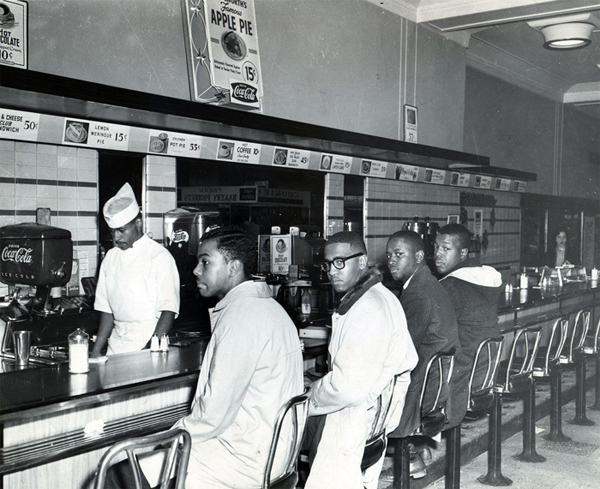Today, 1 February, is the feast day of St. Brigit of Kildare. It brought to mind one of my favorite prayers, which I designed as a piece of art (below).
As it happens, today is also the sixty-first anniversary of the Greensboro, NC “sit-in” movement, when students at the North Carolina Agricultural and Technical State University demanded to be served at a segregated Woolsworth lunch counter.
The extraordinary decision by those students to commit nonviolent resistance against injustice was not done on  impulse. Much preparation went beforehand. This tactic had been tried before but did not spark of movement.
impulse. Much preparation went beforehand. This tactic had been tried before but did not spark of movement.
This one did, triggering similar protests in 55 cities and 13 states. (For more, see “How the Greensboro Four Sit-In Sparked a Movement” in History.) One of my dear friends, then a student at Wake Forest University in nearby Winston-Salem, was among the first white students to join that action.
Right: On the second day of the Greensboro sit-in, Joseph A. McNeil and Franklin E. McCain are joined by William Smith and Clarence Henderson at the Woolworth lunch counter in Greensboro, North Carolina. Photo: Greensboro News and Record
The coincidence of St. Brigit’s feast day and the Greensboro confrontation is a fitting framework to think of the kind of formation people of faith must undertake.
Clearly we need a beatific vision in the manner of Brigit’s prayer. I would say “mystical” vision, but the word in English mostly draws up images of hermits or vaporous apparitions. But, yes, a mystical vision, illimitable, a “thin space” experience where Heaven’s ecstasy and Earth’s agony overlay.
A mountaintop experience, not unlike that of the story of Jesus’ “transfiguration,” when Jesus takes three of his disciples to a peak, where a glorious vision unfolds, with appearance by the Prophets Moses and Elijah.
Blustery Peter suggests tabernacles be built there. But no sooner had the rapturous moment ended, Jesus—ignoring Peter’s impetuous request—says something to the effect of fugetaboutit and leads the three back down the mountain where he is immediately confronted by a man whose son had a “spirit” causing the boy to convulse, grind his teeth, and foam at the mouth, which some commentators think may have been epilepsy.
Jesus heals the boy. And thereby establishes the link between the ecstasy and epilepsy—between mountaintop spiritual experience and the healing of Earth’s destitute, diseased condition.
You may recall that this story in Mark’s Gospel (chapter 9) comes immediately after Jesus’ conversation with his disciples, asking, “who do the people say I am?” Peter gets it right—but not quite right. Then Jesus speaks to them of the trouble to come, of his suffering and eventual crucifixion by Rome’s anti-terrorism task force. Whereupon Peter, in his insolence, adamantly rejects the notion that a sovereign should even suffer, much less die.
We should also be thinking here about Martin Luther King Jr.’s “mountaintop” speech in Memphis, where he had gone to support striking sanitation workers. Some consider that speech to be his most electric elocution.
“I've been to the mountaintop. And I don't mind. Like anybody, I would like to live a long life. But I'm not concerned  about that now. I just want to do God's will. And He's allowed me to go up to the mountain. And I've looked over. And I've seen the promised land. I may not get there with you. But I want you to know tonight, that we, as a people, will get to the promised land. And I'm happy, tonight. I'm not worried about anything. I'm not fearing any man.”
about that now. I just want to do God's will. And He's allowed me to go up to the mountain. And I've looked over. And I've seen the promised land. I may not get there with you. But I want you to know tonight, that we, as a people, will get to the promised land. And I'm happy, tonight. I'm not worried about anything. I'm not fearing any man.”
He continued, “Mine eyes have seen the glory of the coming of the Lord.” The “glory of the Lord” is linked with the demand of sanitation workers for better pay and working conditions.
If you’re going to confront history’s ruinous condition, you got to be infected with some sense of glory to sustain you through the hard times your advocacy will surely provoke.
To sustain the struggle at hand we need Brigit’s visionary prayer, King’s “Dream,” Jesus’ Beatitudes. But make no mistake, the lexicons of these visions—their field of vision, their fleshly context—is infirmity, is animosity, is in every circumstance of the Beloved Community’s rupture.
Heaven’s promise is heard in the midst of Earth’s affliction. Peter’s hesitation over Jerusalem’s confrontation is also our own. Such is the training and testing ground of our spiritually forming work.
# # #

